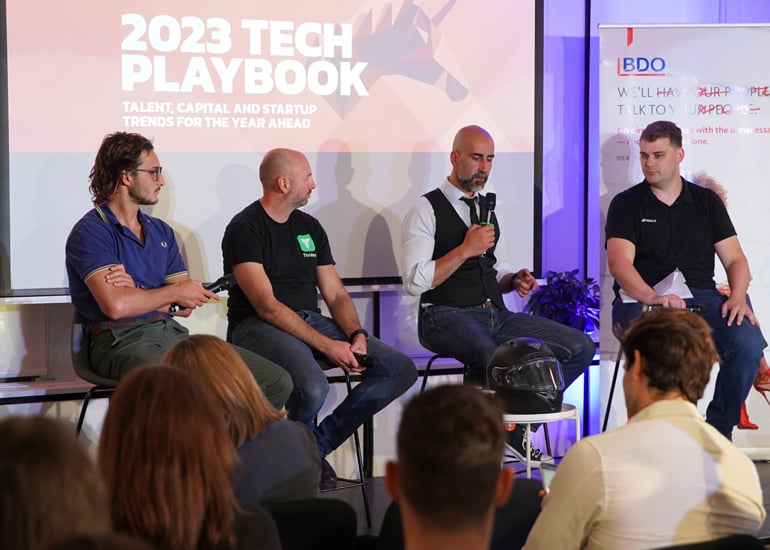

2023 startup trends for Australian founders to scale and grow
source link: https://www.startupdaily.net/partner-content/2023-startup-trends/
Go to the source link to view the article. You can view the picture content, updated content and better typesetting reading experience. If the link is broken, please click the button below to view the snapshot at that time.
News » Partner Content » “How do we keep growing more unicorns?” 4 key startup trends in talent, capital and scaling for 2023
Advice“How do we keep growing more unicorns?” 4 key startup trends in talent, capital and scaling for 2023
Bron Maxabella - December 5, 2022 5 MIN READ

Left to right: BDO Corporate Finance partner Andrew McFarlane, Tidal VC investor Samadhi Pelenda, AirTree Ventures investment manager Raaj Rayat and Startup Daily editor and host Simon Thomsen. Image: Startup Daily.
At Startup Daily’s recent 2023 Tech Playbook From Idea to Unicorn event, our expert panel broke down the key startup trends tech companies need to look out for in the year ahead.
Powered by Microsoft, with community partners BDO and Parallo, the November 17 event at founders’ hub Fishburners highlighted the importance of sharing information and collaborating to develop and grow through the current challenging economy.
“It’s about, how do we create the Australia and New Zealand startup community to be bigger, to get better, to get more startups through, to get more talent, to attract and retain that talent in the country, rather than sending it overseas?” says Andrew Boyd, general manager of digital natives and startup at Microsoft. “And then how do we keep growing more unicorns?”
These are some of the key startup trends that our expert panel want you prepared for in 2023.
1. Pre-seed/seed funding is where the current opportunities are
In 2022, late-stage and technology-growth investing have fallen by as much as 60 per cent year on year globally, but seed funding remains far more robust.
“At the seed to series a stage, certainly for us at AirTree, we’ve done more seed deals this year than than we did last year,” says Raaj Rayat, investment manager at AirTree Ventures. “So there’s a tonne of momentum and a tonne of funding still going into really strong early-stage startups.”
Raaj notes that the focus is on efficiency in growth, not just revenue growth above everything else. This comes down to the burn multiple: “how much new revenue are you adding for every dollar of capital you spend?”
Samadi Pelenda, an investor at Tidal Ventures, adds that the focus is “extending the runway” by having sustainable unit economics. That includes focusing on your CAC (customer acquisition cost) and product-led growth.
2. Recruit for diversity and ditch the formality
This is more than just ticking a box or even demonstrating that you’re an inclusive, accepting organisation. Diversity drives innovation and growth.
To get it right, you need to create a work environment that will appeal to a broad range of people. Rhea Shyamkant, human resources director at Omnistream highlights the importance of balancing the candidate value proposition and employee value proposition. “I think too often I’ve been involved in debates with founders, hiring managers about intrinsic versus extrinsic,” Rhea says. “I truly believe that to hire and retain good talent, you need a balance of both.”
The biggest risk is that you hire for comfort because of your own unconscious biases, says Alan Jones, CEO of Fishburners.
“Let’s say you’re a team of three white male software engineers, 25 to 30 years old. There’s a very high chance that you’re gonna hire… a fourth white male software engineer, 25 to 30 years old. Because that person feels more comfortable in your team, you feel more comfortable with them, but then you miss out all of the benefits of diversity.”
To broaden your comfort zone, Alan suggests setting quotas for applicants and looking for deeper connections. Some of his criteria is that they:
- don’t look like your existing team
- don’t come from the same sort of background
- have different interests
- have different ways of working
In the current talent crunch, Alan advises founders and people leaders to ditch the formality of interviews and try get to know potential talent in different settings. “Most people are prepared to be interviewed within a workplace context and it can be quite a different thing to sit at a café or just go for a walk,” says Alan.
The more informal you can make your interview process, the more you allow your candidate to shine. “We hire for passion mostly because they say skill can be taught and passion can’t,” says Joseph Azar, chief technology officer at Forcite Helmet Systems. “So we try to get people on board by seeing the passion they have when we tell them about the product.”

Have a strong mission and purpose and highlight it to your candidates, advises Rhea Shyamkant. Image: Pinstripe Media
3. Get clever around using new hires and partners to scale
One of the big issues when you’re growing your startup is knowing you need additional human resources, but not in a full-time capacity. Recruiting people on a part-time basis can be problematic, because what happens when you grow large enough to take them on full-time, but they can only commit part time?
Joseph Azar, chief technology officer at Forcite Helmet Systems, says that while this is a really difficult thing to plan for, there’s a solution: “you can’t hire somebody that does one specific thing.”
You need to bring people on board who are prepared to muck in and contribute across the board. “We’re series A going to series B, but we still act as a startup,” he says. “I develop, act as a CTO test, sometimes do sales and marketing, and that’s what we do all year round and everybody does the same. So there’s no one specific person that says, oh, I’m just doing that, you know?”
To get around specialist areas, Forcite hire consultants to do specific jobs when needed. They can ramp up or down in a cost-effective way and can fill the gaps until you’re big enough to hire internally. Just as your staff are working across the company, it’s a good idea to bring partners in who can take a whole-company approach as well. They can bring in fresh ideas and new ways of looking at things, too.
“I think there’s something magical on the creativity side when some people might come in and have ideas or develop new areas of the business that you didn’t know you needed or had,” says Afonso Firmo, co-founder and director at NetNada.

“Hiring somebody outside the company to do that specific job when it’s needed, that’s probably best use of your money, right?” says Joseph Azar, pictured third from left alongside Afonso Firmo, Justin Bohlmann, head of growth at Thriday and Matt Alford, devops engineer at Parallo. Image: Pinstripe Media.
4. Seek funding opportunities outside of VCs
“VCs have too much influence around narrative when it comes to seed stage investing, at least inadvertently,” notes Rafe Custance, venture studio principal at Dovetail Studios. He wants you to look at other opportunities outside of VC funding.
Venture studios are one such approach. Unlike VC funding, a venture studio is closely involved in the operational and strategic direction of the startup they invest in. Because of their strong involvement, venture studios will often back a new business when a VC won’t.
“Something that’s incredibly overlooked and often gets lost in translation is that most businesses at the earliest stage simply aren’t backable…,” says Rafe. “Our thesis is that this leaves a large amount what could be incredible, highly successful, scalable technology businesses as sort of vacant opportunities left on the table.”
Other alternative funding sources include:
- Angel investors – good connections are key here, so network, network, network
- Loans from friends and family – the people who believe in you the most may want to back you
- Crowdfunding – small contributions from many add up to maintaining control of your venture
- Peer-to-peer lending – smallish loans accessed through various platforms
- Small business bank loans – the old-school method of funding still holds true
- Private equity – a possible alternative for those seeking large-scale funding
For more tech startup insights, technical guidance and mentoring advice, head to Microsoft for Startups Founders Hub. Sign up in minutes with no funding required, and you could unlock up to $150,000 in Microsoft Azure credits as you grow.
Watch the entire 2023 Tech Playbook From Idea to Unicorn session here:
More info:
Make sure to sign up to Startup Daily’s newsletter for news updates and more events like this.
This article is brought to you by Startup Daily in partnership with Microsoft.
Recommend
About Joyk
Aggregate valuable and interesting links.
Joyk means Joy of geeK